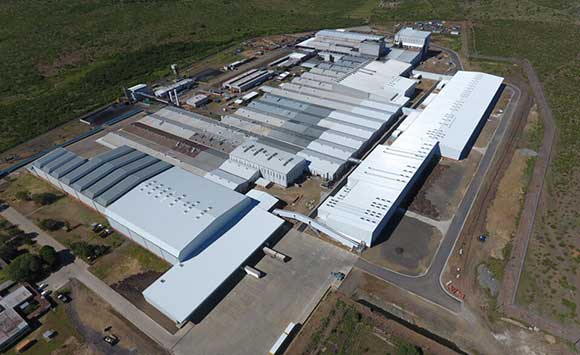
Sumitomo Rubber South Africa (SRSA), manufacturer of the popular Dunlop, Sumitomo and Falken tyre brands, is a division of Sumitomo Rubber Industries (SRI), headquartered in Kobe, Japan.
SRI is ranked the world’s fifth-largest producer of automotive tyres and industrial rubber products and has tyre manufacturing plants in Japan, China, Indonesia, Thailand, Brazil, Turkey, USA and South Africa. The existing South African plant in Ladysmith (founded in 1973) currently produces passenger car, sport utility vehicle, truck and bus tyres, which are sold in South Africa as well as exported.
Recently a major capital investment was made to expand and improve production at the Ladysmith plant. As part of the upgrade, the company wanted to track 14 distinct components through the production process, showing for each part which of the 21 processes it touched, which of the 81 systems or machines processed it, which of the 148 final product moulds it ended up in, and which of the 1000 recipes using 150 raw materials were used to produce the part. And they wanted it in six months please, or lose a major contract – no pressure. That was the challenge posed by Sumitomo Rubber to Bytes Systems Integration.

Design and implementation
800 pages of design documentation based on the ISA-95 standard, 560 pages of user manuals, 240 user screens, 810 systems and sub-systems, over 10 000 system tags later, Sumitomo passed its tracking and genealogy audit by the OEM. The system made use of 44 touch-screen panels HMIs, 59 scanners and 33 barcode printers to enable the functionality needed to track each part in the process to produce OEM products. Bytes used the TrakSys platform from Parsec Automation to develop the solution as result of its configurability, flexibility, scalability and adaptability. The open architecture also allowed fast deployment, exactly what a project of this nature required.
During implementation, a number of challenges were overcome. The time constraint was crucial, but resulted in clear focus and business support that made the solution successful. The complexity of the production process and the sheer number of different processes made it impossible to ‘templatise’ processes for faster configuration and roll-out. The different machines also did not have the same PLC standards and as such it took a big effort to confirm and validate PLC signals to the solution. There was also a requirement to integrate to multiple systems such as a bespoke IT management system, third-party supplied systems and parent company systems.
The solution also needed to be developed and implemented in parallel with a network infrastructure upgrade project, resulting in some rework and other complexities. As with many companies, there were also BOM inconsistencies between the ERP and the actual process in the plant. All these challenges were overcome within the time constraint through a number of crucial management interventions consisting of:
• Weekly Green Area Flash Reports to track the status of the implementation and encourage inter-departmental competition.
• A strong communication strategy resulted in minimal resistance from the shop floor as everyone was well informed as to the reason and importance of the initiative.
• All activities were identified and managed, both from a provider as well as a user perspective.
• All plant disciplines were fully engaged during the whole process to ensure that no critical functions were missed during design and implementation.
• The company intranet Sharepoint portal was used for central document control and project communication during the project.
• Post Go-Live, a three month intense onsite handholding was done on the plant-floor to ensure use and acceptance of the solution.
Based on the success of the project, it was decided to roll out the solution to the rest of the plant (non-OEM) as well as a brand-new plant being built next door. Today, the solution tracks each of the 4300 materials using 3300 bills of materials (BOMs) through 482 processes through a potential of 456 machines using 157 scanners, 142 HMIs and 58 barcode printers to enable full traceability for each of the parts. To add to the complexity of the solution it was also required to track the age of the batches of rubber compound to ensure that they do not age beyond 14 days, as this can impact the quality of the product and result in safe-to-use issues.
The next phase of the project was thus to implement a systemised First-In-First-Out (FIFO) work-in-progress (WIP) storage location system between processes and machines using the same software solution as a base. This tracks material age and indicates when a batch must be used today, within three days or within a week.
In addition to tracking, genealogy and FIFO, the system also monitors equipment and process performance so as to optimise production by looking at throughput, utilisation and quality stages. Machine interlocking was also implemented to ensure that the correct material is being used for the correct process step or that a specific batch of material is not ‘over-consumed’ or ‘under-consumed’ when for instance an operator neglects to scan a new material loaded into the machine/process or fails to ‘complete’ a process step.
Today, the solution is being expanded to manage, control and version recipes for each of the unique products, processes and machines, replacing a plethora of spreadsheets. The relationship between Sumitomo Rubber and Bytes Systems Integration is strong and the solution is going from strength to strength.
For more information contact Gerhard Greeff, Altron Bytes Systems Integration, +27 11 205 7663, [email protected], www.altron.com

© Technews Publishing (Pty) Ltd | All Rights Reserved